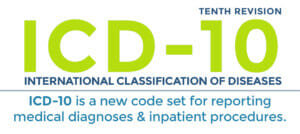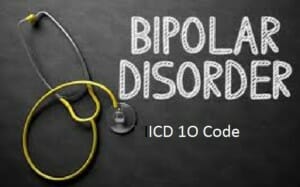Have you noticed that certain codes keep appearing in your medical history? If you have been diagnosed with bipolar disorder, it is associated with certain numerical diagnosis codes used in medical billing.
You might also see that the coding has changed, and this can be confusing. Does this mean that your bipolar symptoms have also evolved, and your psychiatrist neglected to tell you?
Don’t panic or stress. Your mental health disorder hasn’t changed, only the codes used to classify it.
What is ICD-10?
The ICD acronym stands for The International Classification of Diseases, and this is the 10th edition. Previously, there should have been ICD-9 codes in your medical chart. In 2015, the World Health Organization (WHO) finally agreed on the new coding and started using this latest system.
This is why you might see ICD-9 and ICD-10 codes. Nothing has changed regarding your symptoms, only how they are classified.
ICD-10 codes are useful, and important, for several reasons. Healthcare agencies and providers use them to attempt to simplify your medical records. They are also used to track trends, and determine reimbursement by insurance carriers. Furthermore, they are used by healthcare providers to conduct clinical outcomes research.
If you are like most people with bipolar disorder, you need your insurance provider to cover the cost of your treatment. The ICD codes help to ensure that you have the coverage you need to manage and control your symptoms. It also helps insurance companies pay in a timely fashion.
Classifying bipolar disorder with ICD-10 codes also ensures that you are getting the best possible care. It helps to clarify the data your psychiatrist reads in your chart, and this is important if you switch to a new healthcare professional. A reduced risk of a misdiagnosis means that you are more likely to get the right treatment plan for your bipolar disorder.
1
This is crucial in controlling your manic and depressive episodes.
The main difference between ICD-9 and ICD-10 systems for bipolar disorder, is that the revised system now allows for additional information to be coded into your chart. In other words, ICD-10 is more detailed.
ICD-10-CM and ICD-10-PCS for Bipolar Disorder
The United States has divided the coding into two parts. ICD-10-CM is used for diagnostic procedures, and if you need to be hospitalized it will be reflected with an ICD-10-PCS code. Once again, this makes your medical history easier for health professionals to read and can speed up the response by your insurance carrier.
History of Using ICD-10 Codes
ICD codes have been used to identify diagnoses and inpatient procedures since the late 1970s.
It is a coding system that is used by healthcare providers worldwide. What you might not know is that the current ICD-10 codes are actually 25 years old, and have been used by some counties since the mid 1990’s.
This could be important to know if you were previously being treated for bipolar disorder in another county, and have recently moved to the U.S. This will be reflected in your medical chart.
Currently the WHO is updating these codes and plans to release ICD-11 or the 11th edition in 2017, though it will probably take a few years before the United States implements the planned for new system. Currently, ICD-11 is slated to go live in January 2022.
ICD-10 Codes for Bipolar Disorder
There is a long list of health codes for bipolar disorder, and this is beneficial for you.
Since there are now ICD codes for almost every aspect of this mental health disorder, it is easy for doctors to see which symptoms you have and are being or have been treated for.
The ICD codes for Bipolar Disorder are in the “F” series. While they do include,
- Bipolar Disorder Type 1
- Bipolar 1 Disorder
- Manic-depressive reaction
- Manic-depressive illness
- Manic-depressive psychosis
The 10th edition does not have coding for,
- Bipolar disorder with a single episode of mania
- Recurrent major depressive disorder
- Single episode of major depressive disorder
- Bipolar Cyclothymia
It is this lack of ICD codes that has prompted the WHO to release the updated 11th edition.
Some of the specific codes that indicate Bipolar Disorder and your current symptoms at the time of treatment are,
F31.0– current episode of hypomania
F31.1– manic without psychotic features
F31.2– severe mania with psychotic features
F31.3– mild or moderate depressive features
F31.4– severe depression without psychosis
F31.5– severe depression with psychotic features
F31.6– mixed episode
F31.7– Currently in remission
F31.8– Bipolar Type 11
F31.9– Unspecified bipolar disorder
There are also sub-codes which provide additional information. If you want to learn more about the ICD-10 codes for Bipolar Disorder Type 1 or 2 you can find them online at the International Classification of Diseases, 10th Revision website.
ICD-10 Codes and Bipolar Disorder Treatment
These codes do make it easier for healthcare professionals to provide the right treatment for you.
2
One glance at your chart will let them know your history, and this will help them make the right diagnosis. If they see that your bipolar disorder symptoms are typically mild, moderate or severe, they have a better chance of creating a treatment plan that will work for you.
The downside to the current coding system, is that it does not cover every aspect of this disorder. This can lead to misdiagnosis and medications that do not control the symptoms associated with your bipolar disorder. This is especially true if you have bipolar cyclothymia.
While this current International Classification of Diseases will simplify everything from treatment to billing insurance companies, it still does not cover every aspect of this mental health disorder.
It is still important for you to be proactive in your diagnosis and treatment plan, and not rely completely on the ICD-10 codes in your chart.
3
See here for more information Bipolar Treatments.
 Medically reviewed by
Medically reviewed by 
